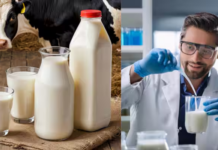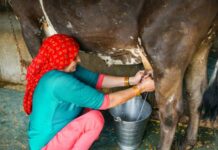The European Union (EU) and the National Inter-professional Centre of the Dairy Economy (CNIEL), a France-based private organisation whose main objectives are to promote dairy products, facilitate relations between dairy producers and processors and make cheese from Europe safe for consumers, hosted two workshops for food bloggers. Of these, one was at Artisan, Sofitel, Bandra Kurla Complex (BKC), Mumbai, and the other took place at Chrie, New Delhi.
The two events, intended at creating awareness about cheese in India and showcasing the diversity of French cheese, were preceded by a networking event in Mumbai (where vegetarian cheese was tasted). It was attended by food journalists, critics, bloggers, culinary specialists, food importers, chefs and restaurateurs. These will be followed by a consumer promotion campaign at Foodhall and Hypercity outlets in New Delhi with a series of cheese tasting sessions. These will conclude on April 23, 2017.
Europe, by far, is the producer of the world’s best cheese. Artisans and big producers use their ancestral know-how to produce a wide variety of cheese, including Camembert (a French cheese) and Burrata (an Italian variant). The dairy industry in the EU is not just the most productive and most successful in the world, but has also laid down strict regulations.
Francois Robin, a French chef who has earned the honour of being the country’s best cheese monger, demonstrated exclusive recipes based on the available cheese, which does not contain any animal rennet, and added an Indian touch to create fusion food, using it as the main ingredient. All the cheese available for tasting allow the Indian patrons to enjoy the best offerings of the European country.
Cheese consumption in India
Positive trends indicated that sales of cheese in 2016 were estimated at Rs 23 billion with sales of 60,400 tons and are expected to almost double in value to Rs 40 billion with sales of 1,00,000 tons in 2021.
Although the consumption of cheese has increased by 15-20 per cent in India in recent years, the consumption of cheese in the country is quite low vis-a-vis the global consumption (200g versus 7kg). However, food habits are changing. This is largely due to the fact that disposable incomes are increasing, and Indian consumers are open to acquiring new tastes. Also traditionally, Indians are big consumers of dairy products, and cheese is consumed either as a part of meals or as a snack.
France ranks third as a supplier of cheese to India after Italy and Denmark, with a market share of around 13 per cent, and the consumption of French cheese has been steadily rising in India. Spreading awareness about the variety, textures and qualities of French cheese is very important and an adaptation to local tastes is necessary to increase consumption, since cheese is not only tasty, but also an important source of protein.
The distribution of cheese and the regulatory environment are still challenges. However, the availability of imported cheese in gourmet stores across India and the innovations offered by companies are helping to develop the market.
Cheese is divided into four types – soft, semi-soft, hard and blue.
Soft: It is ripened from the outside in with a white rind, often runny at room temperature. Examples include Brie, Camembert, Reblochon and Mont d’Or.
Semi-soft: It has a smooth or creamy interior with little or no rind. The flavour ranges from mild to pungent. Examples include Raclette, Abondance, Morbier and Port Salut.
Hard: It has a firm texture with tastes ranging from mild to pungent and is easy to grate. Examples include Emmental, Beaufort, Mimolette and Tomme de Savoie.
































